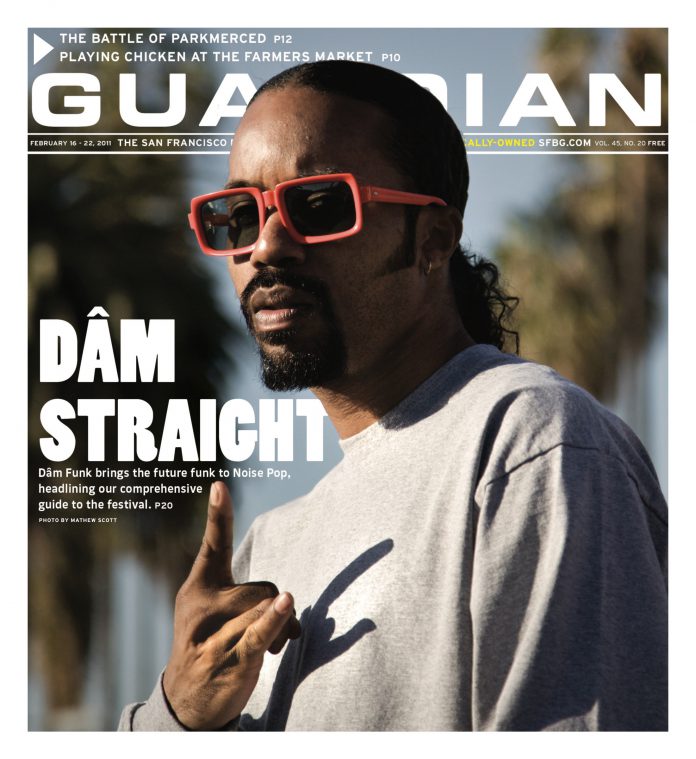arts@sfbg.com
FILM It’s hard to recall an American independent film so good naturedly horny — and unexpectedly poignant — as Gregg Araki’s Kaboom. A screwball comedy for the Coachella set, Araki’s crackerjack death trip is a return to the devil-may-care form of The Doom Generation (1995) and Nowhere (1997). Our coed heroes are Stella (Haley Bennett) and Smith (Thomas Dekker), and they’re the only platonic thing in the movie. A cult-bidden mystery is perhaps a little too squarely accounted for, but that hardly matters when Kaboom is sliding up and down the Kinsey scale, huffing comic book paranoia for the fun of it and expurgating the teen sex romp of its straight-laced intolerances. Araki was kind enough to speak to me before the film had its local premiere at the San Francisco Independent Film Festival.
SFBG You have described Kaboom as an old-school Gregg Araki film. What does that mean to you?
Gregg Araki One reason I wanted to make the film was that I wanted to do an old-fashioned cult movie — a movie that’s really outside the box and a little crazy. As a filmgoer, I’m sort of bored with everything being the same. Kaboom is weird because it has broad appeal, but I want the cult audience to be able to claim it as their own. With The Doom Generation and Nowhere, I don’t even know how the cult of those movies developed. There was just the theatrical distribution and video at that point — no Internet, no Facebook, no Netflix. I really don’t know how a lot of kids even saw those movies! It’s really exciting for me to think that that cult is so much bigger today. But I’m older now and hopefully a little wiser, and I’m just not the same person as I was for The Doom Generation. Whenever The Doom Generation would play a festival, after the movie the audience would look shell-shocked. When Kaboom premiered at Cannes, right after the movie ended the audience started to cheer. It screened Saturday at midnight, and afterward the audience was ready to party — there was this weird, electric vibe. There’s more warmth and fondness to this new movie.
SFBG You feel a real tenderness toward all the characters.
GA It sounds crazy to say with this story, but Kaboom is the most autobiographical movie I’ve ever made. So much of what Smith is about and the specifics of his character are me. The scene where Smith is at a club and he’s listening to the band with that look on his face — that’s such a resonant scene for me. There’s a real kind of nostalgic love for all the characters.
SFBG How does that play out in the sex scenes? Besides being hilarious, I was impressed by how much the characters remain themselves in these moments.
GA I think my films have always been fascinated by sex and sexuality, but it’s never really been in a titillating or lascivious way. They’re really about getting access to those most private, intimate moments between characters. The sex scenes in my movies are always about that — the emotional nakedness as opposed to just the physical nakedness. I love the sex scenes in Kaboom to death because there’s just so much going on with the characters. You’re learning so much about them in those scenes.
SFBG You’ve talked about Twin Peaks being a big influence on Kaboom.
GA David Lynch is a huge influence on all my films, but this one especially.
SFBG It’s obviously there in the style and mystery of it. But I was also curious about its being a television serial might be important. There are all these stretches in Kaboom where it feels like you’re watching three or four-minute tight episodes in fast succession — all this crazy shit keeps piling up. It reminded me of what getting hooked by a TV show is about, but in a compressed way.
GA Yeah, someone told me that there’s basically a whole season of a show in this one movie. I worked on Kaboom for years, and in a different incarnation it was actually developed as a TV show. So it definitely has a relationship with that kind of storytelling, but there was a point when it just made more sense to make a movie. The first cut of Kaboom was half an hour longer, but I wanted the movie to play like a roller-coaster ride, where you get on and then it’s sort of over before you know it — again, with the idea that the cult audience can just pop it in over and over. If it was three hours long, that wouldn’t work.
SFBG Another thing that gives Kaboom the feeling of a ride is the wall-to-wall soundtrack. A lot of short scenes have three or four distinct music cues.
GA We had the score composed by four people and then on top of that we had about 30 songs. Every one of them is a personal favorite. The music is always where a lot of my inspiration comes from. A lot of the mood and spirit of Mysterious Skin (2004) is in the Robin Guthrie and Harold Budd score. If you listen to the soundtrack of Kaboom, you can almost see the movie in your head. So much of what the movie is to me is atmosphere. And so much of that atmosphere is created through the music.
SFBG And it fits with that time when you’re living in a dorm and music is coming at you from all sides.
GA I still live that way. I get up in the morning and before I even turn on the coffee, I turn on my stereo and listen. It’s always playing. When I write, too. It’s such a big part of my life — so of course it’s there in my movies. *
KABOOM opens Fri/18 in Bay Area theaters.

